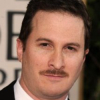Darren Aronofsky

Darren Aronofsky
Darren Aronofskyis an American film director, screenwriter, film producer and environmentalist. He has received acclaim for his often surreal, disturbing films and has been noted for frequent collaborations with cinematographer Matthew Libatique, film editor Andrew Weisblum and composer Clint Mansell. His films have generated controversy and are known for their often violent, bleak subject matter. "The themes in the six Aronofsky’s films from 1998 to 2014 include the search for perfection, the search for happiness, longing for love, intoxication with...
NationalityAmerican
ProfessionDirector
Date of Birth12 February 1969
CityBrooklyn, NY
CountryUnited States of America
I'm Godless. And so I've had to make my God, and my God is narrative filmmaking, which is -- ultimately what my God becomes, which is what my mantra becomes, is the theme.
Comic books and graphic novels are a great medium. It's incredibly underused.
These wrestlers aren't organized. They have no union, no pension and no insurance. You meet wrestler after wrestler who sold out Madison Square Garden ten years ago, basically running on fumes today. There's a lot of drama there.
CGI means, just to be clear, creating any type of image with a computer. Basically, starting off with nothing, or with images and manipulating them. The way we did it, everything was actual photographed images. A lot of that stuff was shot through a microscope of chemical reactions, yeast growing, lots of weird things, by Peter Parks. We put it into a computer and collaged it, manipulated it. Meaning we digitally shaped it to fit with other images. But there was no computer-generated imagery at all.
I hope that Requiem is better than Pi. I hope that Pi is better than my student films, and I'm hoping that I'm getting better as I get older.
I've always wanted to introduce hip-hop filmmaking to film. There's hip-hop art, dance, music, but there really isn't hip-hop film. So I was trying to do that.
I'm Godless. I've had to make my God, and my God is narrative filmmaking
I feel that so many sci-fi films and films in general have just become really dependent on and addicted to CGI, and that some of the big CGI films of the summer, you see these effects that look like crap. You don't know if you're watching a cartoon or something that's real. And I didn't want to fall into that trap. I really thought there was a way to use a lot of these old techniques to do some new and really neat stuff.
I wasn't a big fan of social anthropology. And, luckily, that created room for me to work in visual arts because I sort of ignored my requirements. I think I was attracted to social anthropology because I liked to travel and was always interested in far-off places.
I think video games and that stuff should be as violent as possible, but age-appropriate. It should be realistic. When it's not realistic you run into kids running around shooting people and not realizing the consequences.
Every film had its own grammar. And it's your job as a director to basically figure out a language to tell a story.
The whole visual language of the movie is developed way before we get to set. Especially when you're doing visual effects and you don't have a lot of money to mess around, which we didn't, you have to really preplan everything. Pretty much every shot in the film was figured out months before we got to set.
I think that there's an infinite amount of places where you can stick a camera. There's an infinite amount of choices of what could be going on. There's an infinite amount of places for so many things, so you have to figure out how to do your job.
Also expressionistic filmmaking - making the audience feel like they were inside the characters' heads. And so we create all these different types of techniques to put the audience there.